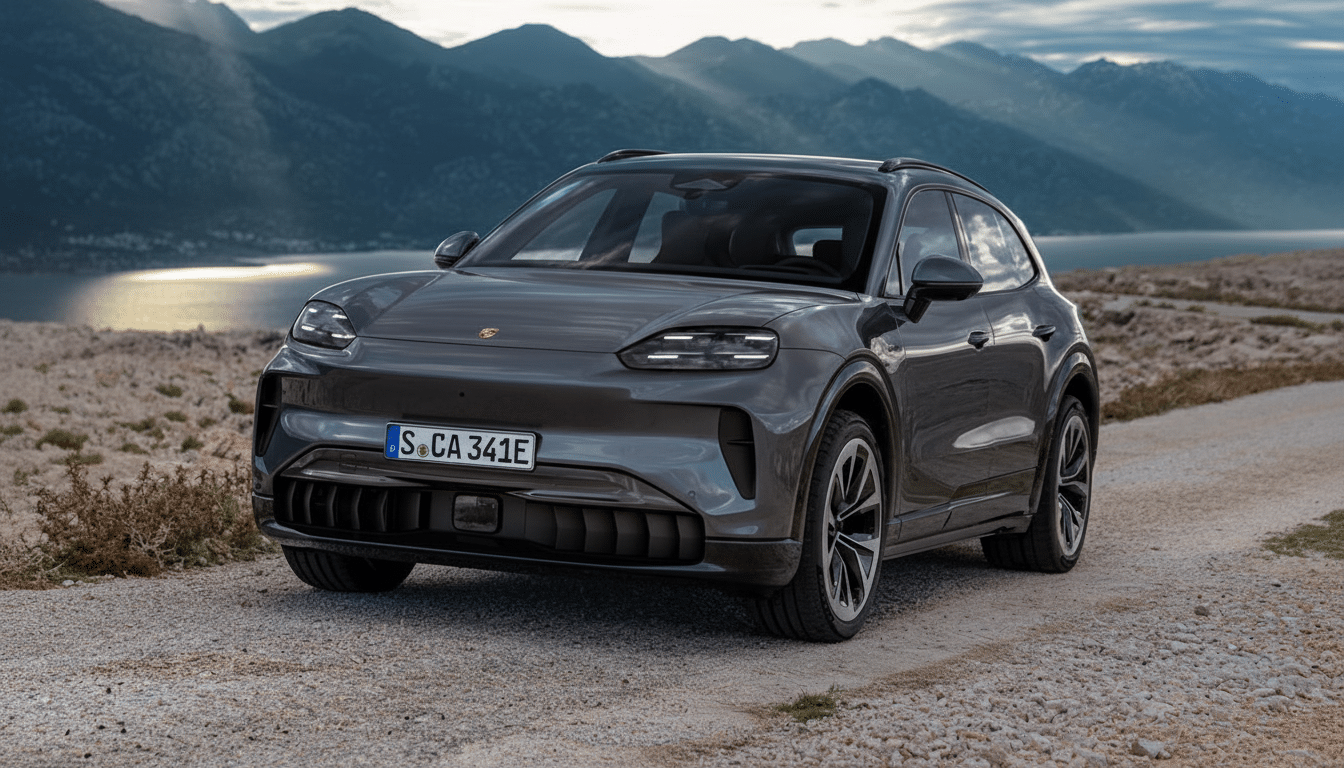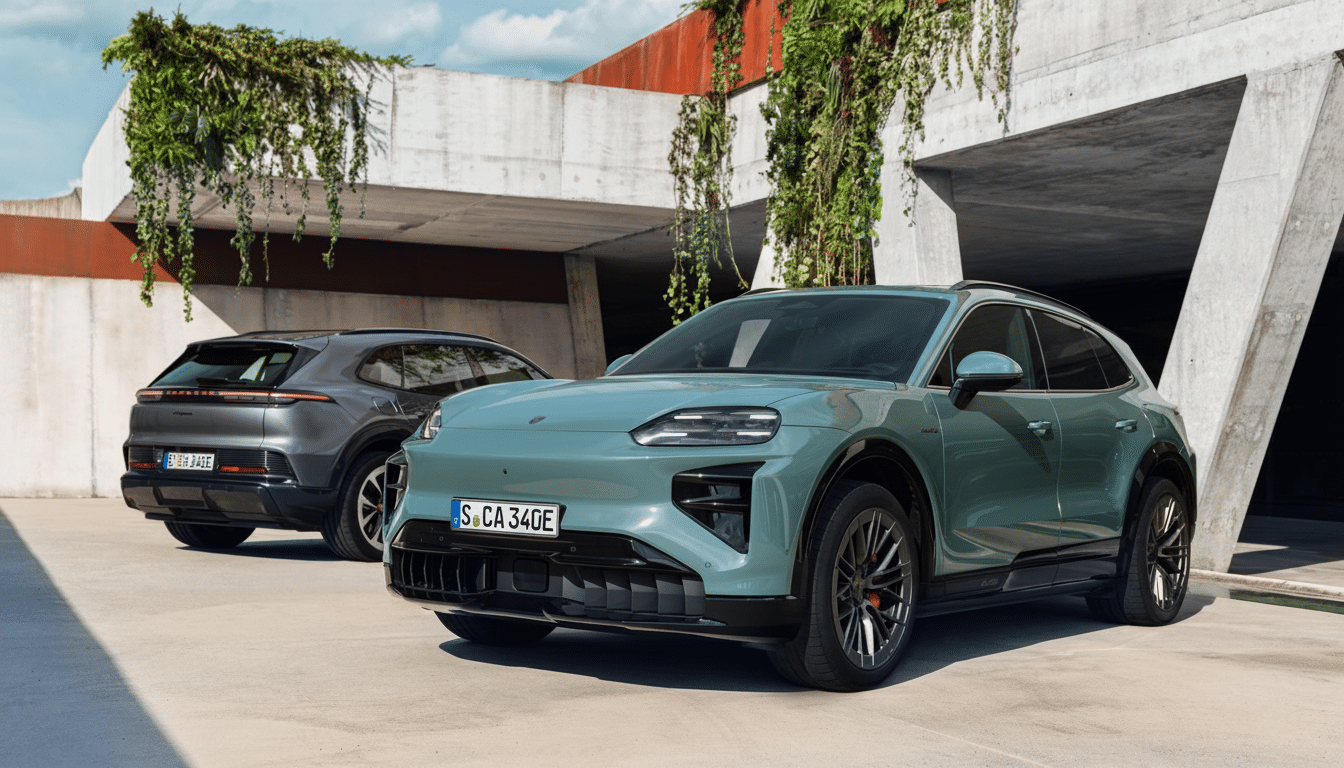Porsche’s new Cayenne Electric debuts with a headlining feature that sets out to address the single biggest everyday EV pain point: an optional inductive system that will let owners recharge by simply pulling into a parking spot over a floor pad.
No plugs, no cords—park, charge and go. That’s paired with hyper-performance, a huge battery and ultra-rapid DC capability, which combine to make the brand’s biggest SUV one of the most technically complete electric models yet.
- How Porsche’s Inductive Charging System Works
- Performance and Range for the Cayenne Electric SUV
- Charging Speeds and Infrastructure for Daily Use
- Design and Interior Tech in Porsche’s Electric SUV
- The Importance of the Wireless Component for EV Adoption
- Pricing and Availability for the Cayenne Electric Lineup

How Porsche’s Inductive Charging System Works
Utilizing a static, ground-mounted charging plate and a receiving coil attached underneath the vehicle, the factory option creates an alternating magnetic field—wirelessly transferring power at up to 11 kW.
That’s the equivalent of a powerful Level 2 home wallbox and, given the Cayenne’s WLTP economy, should add around 30–40 miles of range per hour plugged in. The system has guidance to assist drivers with positioning the car over the pad, and it’s designed to work with foreign object detection and living-object protection—important safeguards detailed by the standards organization SAE International’s J2954 standard for light-duty wireless charging.
Wireless EV charging isn’t entirely new, but Porsche is bringing it to the mainstream luxury segment at levels farm folks and suburbanites can live with. BMW trialed a limited 3.2 kW pilot on the 530e plug-in hybrid, and an Oslo taxi service for the Jaguar I‑Pace utilized inductive pads at 50 kW to allow hands-off, high-uptime fleet operation. The subject of heavy-duty and high-power work is under way in loosely related standards, which follow the current testing format down to passenger-vehicle 11 kW power levels. Even in lab and field testing by industry participants like WiTricity and SAE working groups, overall end-to-end efficiency has been competitive with plug-in AC charging when aligned correctly.
Performance and Range for the Cayenne Electric SUV
The Cayenne Electric’s numbers are classic Porsche, but now they’re silent. The 850 kW (1,156 PS) Turbo is capable of 0–100 km/h in 2.5 seconds and a top speed of 260 km/h, while the sprint from standstill to 200 km/h takes just 7.4 seconds. Not even the entry model is shy, with 300 kW and a 0–100 km/h time of 4.8 seconds.
Both performance and long-distance capability are underpinned by a 113 kWh battery. Porsche is aiming for a WLTP range of up to 642 km for the Cayenne Electric and as much as 623 km in the case of the Turbo. The company also notes “Formula E levels of recuperation,” and says the motors are able to accommodate around 97% of all braking events a driver experiences in everyday road driving without needing to touch the friction brakes. As well, the optional Porsche Ceramic Composite Brakes are still on the menu for those who foresee repeated high-speed stops.
Charging Speeds and Infrastructure for Daily Use
Beyond the cable-free setup, the headline charging stat is up to 400 kW DC at compatible high-power chargers. Actual session times in the field will be a function of infrastructure spread and charge curves, but that ceiling is well ahead of the 250–350 kW one still often found at today’s premium networks. At home, the 11 kW inductive system makes daily top-ups a background task—a blessing in garages or driveways where cords are inconvenient or represent a tripping hazard.

Though WLTP range is relatively generous, U.S. EPA figures typically result in a lower final range, especially in areas where battery thermal systems are stressed with cold weather and frequent fast charging (and every ounce of energy needs to be pushed into those cells). The bright side is that, according to the Cayenne’s thermal strategy and high recuperation rates, on most commutes we shouldn’t rely too much on fast DC stops.
Design and Interior Tech in Porsche’s Electric SUV
The styling is kept simple and familiar—more aero than attack. Practicality remains: the SUV stretches 4,985 mm long with 781 liters of cargo room, and this balloons to 1,588 liters with the seats flopped down, plus an additional frunk packing 90 liters. Dynamic hardware includes adaptive air suspension as standard, rear-axle steering optional, and an optional Porsche Active Ride system that tries to eliminate body movements for eerie poise.
Inside, it’s a screen-forward cockpit dominated by a 14.25-inch digital instrument cluster with an optional 14.9-inch passenger display that makes for Porsche’s largest combined viewing area ever. Seating position, ambient lighting, audio, display themes and climate are also choreographed within a new “Mood Modes” layer that will allow you to adjust the car for particular moments—an EV-age layer above the brand’s driver-centric ergonomics.
The Importance of the Wireless Component for EV Adoption
Convenience is conversion. Charging friction perennially emerges in industry research and owner surveys as a factor dragging down satisfaction with EVs. Wireless closes a common-sense loop: if you park at home, you’re charging. That in turn raises the overnight state of charge, reduces dependence on public charging and is especially useful for drivers with mobility limitations or shared garages that make cords impractical. Fleet examples—from taxi pads in Oslo to depot pilots across Europe and into the United States—demonstrate how cordless charging improves uptime, and how operation is easier.
This is a measure of broader market momentum, too. The International Energy Agency’s latest outlook reports double-digit global EV market share, as well as the rapid expansion of home and workplace charging. As standards such as SAE J2954 settle down, look for other automakers to turn inductive charging into a box you can check—especially as suppliers proliferate 11 kW systems and begin developing higher-power versions. Wireless pilots embedded in the road in the Motor City and Italy all hint at a future where charging becomes seamless—stationary or when moving.
Pricing and Availability for the Cayenne Electric Lineup
Orders are open. In the U.S., the least expensive Cayenne Electric is priced at $111,350 and the cheapest version of the Cayenne Turbo Electric will set you back a minimum of $165,350. As for the inductive charging pad, that’s an extra cost, which will vary by market. For home charging users who care as much about daily convenience as ultimate speed, the cable-free setup could be one of the most transformative features of Porsche’s latest electric SUV.

